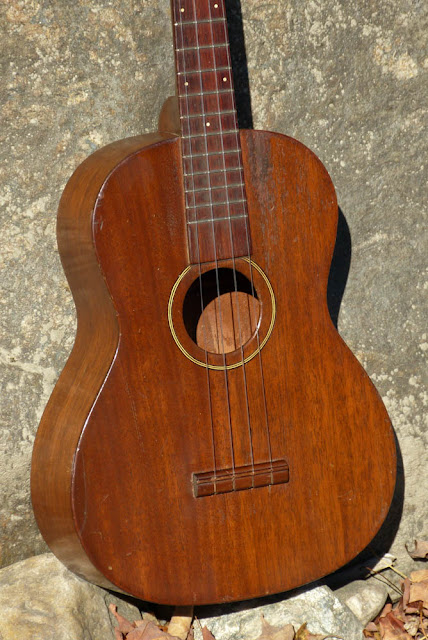1930s Gretsch American Tenor Ukulele
Talk about rare finds! The only other Gretsch tenor uke from this time (late 30s, early 40s) that I've seen was in a clip on YouTube. It should be said, however, that tenor ukes from this time are generally rare anyhow -- no matter who made them! This 12-fret, 17" scale tenor obviously apes Martin aesthetic but is undeniably "Gretsch" in its design and styling. That's true of the other "Gretsch American" products of the time (take for example this other uke) which definitely took their cues from Martins.
This is an all-solid mahogany uke with a Brazilian rosewood fretboard and headstock veneer. It's lightweight and has fairly standard tenor uke dimensions... save that the 12-fret build puts the bridge slightly more in the top's "sweet spot." The nut is 1 3/16" wide with a flat board profile, the lower bout is 9" across and the side depth is 2 7/8" at its deepest. It's obviously been played a bunch (note the strumming finger-wear at the upper bout!) but has a nice, well-loved look to it. The sound is sweet, chimey, and punchy with a nice lingering sustain. Really -- it sounds a lot like a Martin concert or tenor uke to my ears with perhaps a bit more of the Gretsch "zing" or "snap" in the way the sound leaps out front.
This is an all-solid mahogany uke with a Brazilian rosewood fretboard and headstock veneer. It's lightweight and has fairly standard tenor uke dimensions... save that the 12-fret build puts the bridge slightly more in the top's "sweet spot." The nut is 1 3/16" wide with a flat board profile, the lower bout is 9" across and the side depth is 2 7/8" at its deepest. It's obviously been played a bunch (note the strumming finger-wear at the upper bout!) but has a nice, well-loved look to it. The sound is sweet, chimey, and punchy with a nice lingering sustain. Really -- it sounds a lot like a Martin concert or tenor uke to my ears with perhaps a bit more of the Gretsch "zing" or "snap" in the way the sound leaps out front.
When it came in, several seams were sprung, both main top braces were
coming unglued, and the top had two hairline cracks at the lower bout
edges that needed gluing as well. It was also (originally) setup with a
tailpiece string load (interesting!), though I've modified that by
installing a regular uke-style bridge instead (an old one from my
parts-bin). The bracing was definitely strong enough internally for
regular stringing as it follows the standard "one main brace plus bridge
plate" uke model. All the work is done plus a fret level/dress,
cleaning, and good setup to boot. It plays perfectly with 1/16" action
at the 12th fret and is strung with a set of Martin fluoro strings.
One back brace (the lowest one) is missing but I don't see any need to replace it as it's structurally good to go.
Nice veneer, huh? Original bone nut, too.
The "micro dots" are always classy.
I added this bridge -- so, of course, it's a fresh glue job.
The "Gretsch American" stamp at the back of the headstock is badly worn but is much more readable if you get the imprint glinting off of the finish (as in: not seen that way in this pic).
Here you can see where a tailpiece was installed from the factory. Since most folks aren't into that setup these days I figured it was a feature not necessary to retain... and no doubt the uke sounds better because of the change.
I can only think that the reason they had this setup was to allow the use of steel strings if desired -- something that had happened at one point, too, as the frets were worn a bit in first position (something that never happens with gut/nylon, really).
A duct-taped old chip case comes with it.




















Comments